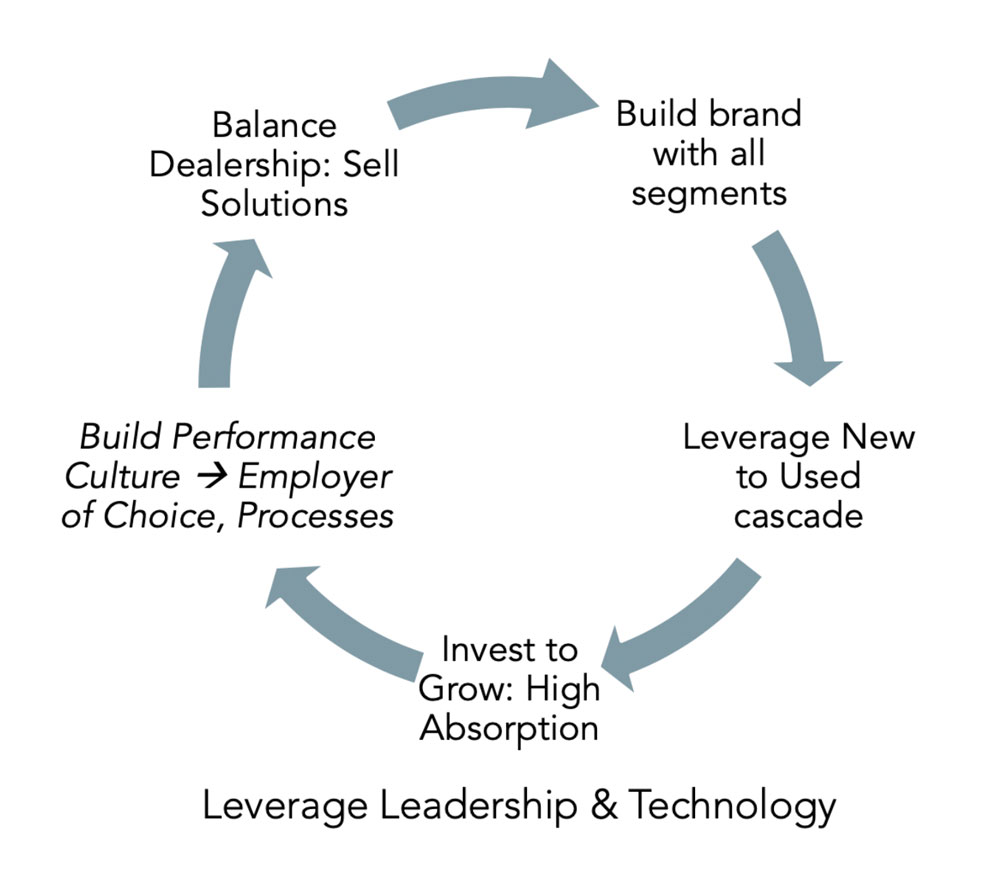What is the New to Used Cascade and why is it important as the first spoke to describe in the Good to Great Dealership Flywheel?
There are many implications for leveraging the New to Used Cascade, which is why I choose to start our journey here. The biggest implication is the fundamental approach a dealership makes to selling machines.
Some dealers are in business to sell new equipment and trading in and selling used is a cost, or necessary consequence. Other dealers choose to be in the used equipment business, and selling new is the way to build a large population of used machines to service.
As new machines are sold and then traded in to sell to successive owners, there is a cascade of a machine from
- New to first used buyer, then
- First used buyer to second used buyer, then
- Second used to third used, and so on.
An “A type” production farmer typically prefers to buy new equipment. Some will only buy new and want to trade-in on another new piece quickly to avoid downtime. The used cascade is also about shifting machines
- From A to B buyers
- From B to C buyers,
- To the many D type customers who are often the last owners because a machine is scrapped or kept for show.
Used Valuations Can Make or Break a Dealership
Because each used machine is unique, when it is traded in, the value is not certain. The value can be affected by number of hours, type of usage, options and attachments and market demand for the type of technology. Determining the value is critical to ensure that the cash in the trade-in does not stay idle too long before resale.
In addition, ambitious sales reps often over-value the trade-in to lower the new price. The best dealerships have a disciplined process to determine market value of used machines and combine many data sources to get it right. The best dealerships also recognize if a trade-in is over, they cut their losses, take the hit on their expenses by lowering the book value or selling it wholesale.
Pre-Selling Used
Because of the cascade of a machine to different buyers and because of cashflow implications of holding used machines in inventory, the best dealership will push sales reps to pre-sell used machines. This can happen when a first used buyer — often a farmer who likes the lower price of a low-hour machine — is approached by a sales rep who knows of a new buyer whose machine fits the first used buyer’s needs. The sales rep might then approach the new buyer with the opportunity of giving them an assured price for trading in their machine, then turning right around to sell to the first used buyer, and in the best case selling the first used buyer’s machine to a second used buyer.
Washout Cycle
Washout is a good metric for the used equipment business. With the cascade through several trades, the true profit on a New machine sale is not known until the last trade-in in the cascade is sold. Only then can the total amount of cash received over the several trade-ins be compared to total paid for a new machine from the OEM.
Many dealers do not calculate washout, but the most knowledgeable people in the used equipment business state that this is the best metric for managing the used business. The metric is the number of trades before the cash in exceeds the cash out.
Many dealers pay their sales their full compensation for a new sales only when the washout profit is calculated.
Driving Service & Parts Sales
The last and most important reason for leveraging the New to Used Cascade is because of the service and parts business opportunity from a larger population of used machines in your AOR.
More machines in your AOR are better, but to realize the opportunity a dealership must actively market to all tiers of buyers (A, B, C and D) with all products and services. This relates to the prior spoke on the Flywheel “Build (your dealership) Brand with all Segments” and directly affects the next spoke “Invest to Grow: High Absorption.”







